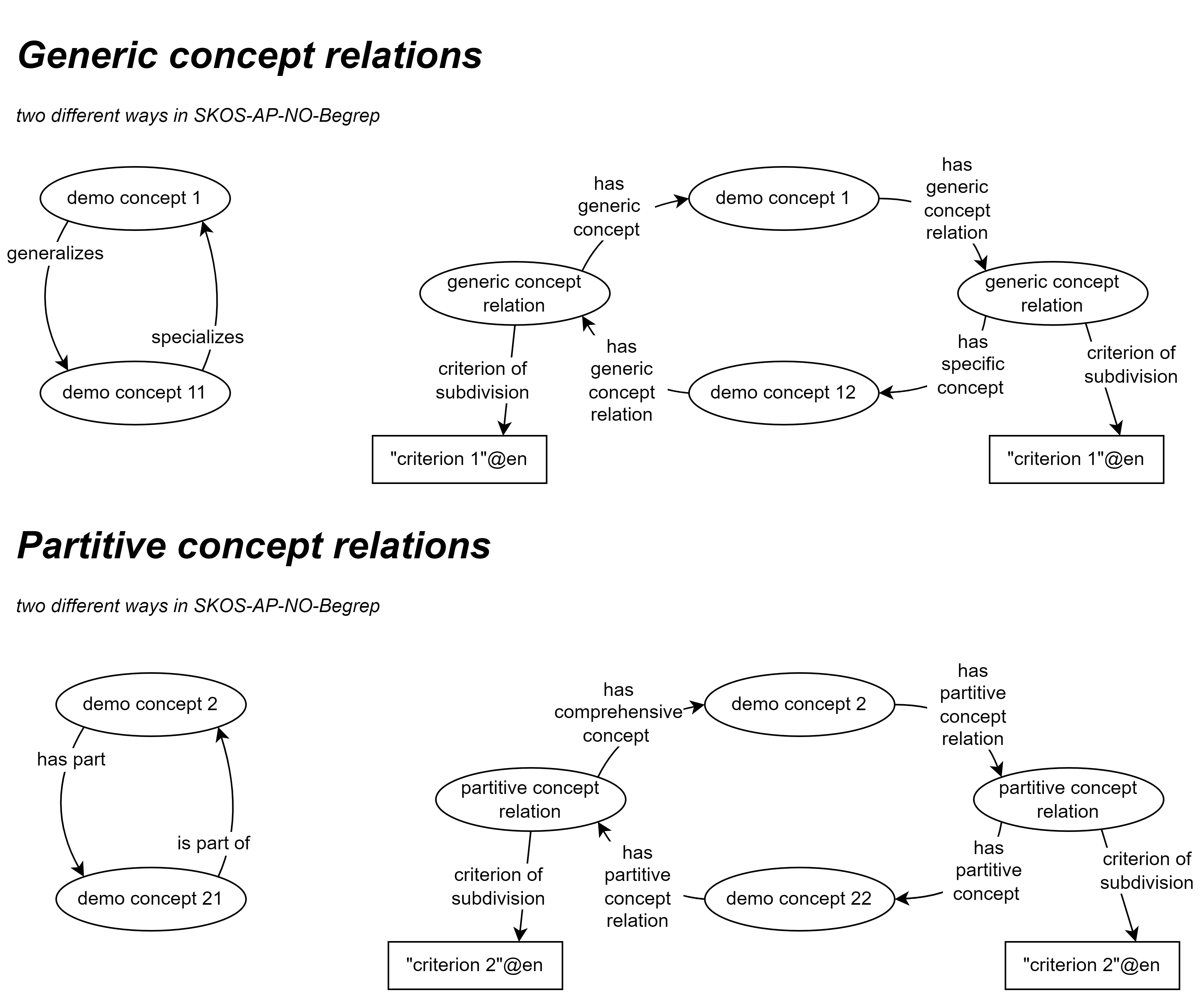Velkommen til utstillingsrommet med demobegreper, som demonstrerer bruken av SKOS-AP-NO-Begrep!
SKOS-AP-NO-Begrep ⧉ er den norske applikasjonsprofilen av W3C sin SKOS ⧉, for beskrivelse og publisering av begreper og begrepssamlinger.
Tilbakemelding: Vennligst registrer eventuelle tilbakemeldinger som Github Issues ⧉.
Forbehold: Demoressursene tilgjengeliggjort via de enkelte utstillingsrommene er kun ment for demo- og testingsformål.
Resten av teksten er kun på engelsk.
Purpose
This showroom is meant to
-
demonstrate machine-readable concept descriptions in accordance with SKOS-AP-NO-Begrep v.2.x;
-
demonstrate in particular how to describe concept relations, in accordance with SKOS-AP-NO-Begrep v.2.x;
-
demonstrate some cross-references between concepts and other resources demonstrated in some of the other showrooms;
-
provide reusable, machine-readable concept descriptions, for testing and demonstration purposes.
Disclaimer: The machine-readable demo concepts are meant for demo purposes only. They do not represent any real world concepts at all. On the other hand, they are supposed to syntactically conform to SKOS-AP-NO-Begrep v.2.x.
Demo resources in this showroom
In this showroom we have a collection of demo concepts:
-
The demo concepts will be automatically harvested to and thus also (not yet) be findable via the demo portal ⧉.
-
There are seven concepts ⧉ in the collection ⧉, where
-
"demo concept 1" is a generalization of "demo concept 11" and "demo concept 12"
-
"demo concept 11" is a specialization of "demo concept 1"
-
"demo concept 12" is a specialization of "demo concept 1"
-
in this generic relation ⧉, "demo concept 1" is the superordinate concept ⧉ / generic concept ⧉, while "demo concept 11" and "demo concept 12" are subordinate concepts ⧉ / specific concepts ⧉
-
-
"demo concept 2" contains "demo concept 21" and "demo concept 22"
-
"demo concept 21" is part of "demo concept 2"
-
"demo concept 22" is part of "demo concept 2"
-
in this partitive relations ⧉, "demo concept 2" is the the superordinate concept ⧉ / comprehensive concept ⧉, while "demo concept 21" and "demo concept 22" are subordinate concepts ⧉ / partitive concepts ⧉
-
-
"demo concept 3" illustrates the usage of all syntactically possible relations that a concept may have with other concepts, in accordance with SKOS-AP-NO-Begrep v.2.x.
-
"demo concept 2" illustrates the usage of all the other properties. "demo concept 2" and "demo concept 3" together illustrate therefore how to syntactically use all the properties in a concept description, in accordance with SKOS-AP-NO-Begrep v.2.x.
-
-
Click for the concept diagrams.
More about concept relations
Hierarchical concept relations
There are two types of hierarchical concept relations: generic and partitive.
Figur 3 illustrates some of the hierarchically relations between the demo concepts that are in the above mentioned collection.
The figure illustrates in particular the two different ways in SKOS-AP-NO-Begrep v.2.x to describe a hierarchical concept relation, depending on if there is a need to specify the criterion of subdivision ⧉:
-
The straightforward way, when there is no need to specify the criterion of subdivision:
-
by using the property specializes (xkos:specializes) ⧉ or generalizes (xkos:generalizes) ⧉ for generic concept relations, demonstrated by the generic relations between "demo concept 1" and "demo concept 11"
-
by using the property has part (xkos:hasPart) ⧉ or is part of (xkos:isPartOf) ⧉ for partitive concept relations, demonstrated by the partitive relations between "demo concept 2" and "demo concept 21"
-
-
Via a generic/partitive concept relation, when there is a need to specify the criterion of subdivision:
-
by using the property has generic concept relation (skosno:hasGenericConceptRelation) ⧉ referring to a generic concept relation in which the criterion of subdivision is specified, demonstrated by the generic relations between "demo concept 1" and "demo concept 12"
-
by using the property has partitive concept relation (skosno:hasPartitiveConceptRelation) ⧉ referring to a partitive concept relation in which the criterion of subdivision is specified, demonstrated by the partitive relations between "demo concept 2" and "demo concept 22"
-
Associative concept relations
While there are only two types of hierarchical concept relations as demonstrated above, there is an unlimited number of types of associative concept relations.
In SKOS-AP-NO-Begrep, some types of associative relations are explicitly supported, demonstrated by "demo concept 3":
SKOS-AP-NO-Begrep of course also allows you to specify your own types of associative concept relations, by using the property is from-concept in (skosno:isFromConceptIn) ⧉ referring to an Associative concept relation (skosno:AssociativeConceptRelation) ⧉ in which you may specify the role that the concept has towards the other concept in the associative relation between the two. This is also demonstrated by "demo concept 3".
More about concept definitions
There are also two different ways to specify the definition of a given concept, depending on if there is a need to specify more details in addition to the definition text:
-
The straightforward way, when only the definition text is to be specified, by using the property definition (direct statement) (skos:definition) ⧉, demonstrated by "demo concept 1".
-
Using the property definition (via definition object) (euvoc:xlDefinition) ⧉ referring to a Definition (euvoc:XlNote) ⧉ in which more details about the definition are specified. This is demonstrated by "demo concept 2", where details about the source and the audience of the definition are given.
Some cross-references with other demo resources
Note: Not all possible cross-references are demonstrated in this showroom. The lists are thus not exhaustive.
Concepts and classifications, for example:
-
A concept may refer to a classification as its value range.
-
Our "demo concept 2" refers to our "demo controlled vocabulary 1" (demonstrated in our showroom with demo classifications) as its value range (skosno:valueRange) ⧉.
-
Classifications should therefore be made available, also machine-readably.
-
-
A concept may be included in or referred to from a classification.
-
This is demonstrated and explained in our showroom with demo classifications.
-
Concepts and datasets, for example:
-
A dataset may refer to concepts that the dataset represents or concepts that are relevant for understanding the dataset.
-
This is demonstrated and explained in our showroom with demo datasets.
-
-
When describing a dataset, and where coded values are used, the coded values should preferably be concepts chosen from controlled vocabularies (i.e., classifications).
-
This is demonstrated and explained in our showroom with demo datasets.
-
Concepts and information models, for example:
-
An information model may refer to concepts that the information model represents or concepts that are relevant for understanding the information model.
-
This is demonstrated and explained in our showroom with demo information models.
-
-
When describing an information model, and where coded values are used, the coded values should preferably be concepts chosen from controlled vocabularies (i.e., classifications).
-
This is demonstrated and explained and explained in our showroom with demo information models.
-
Concepts and services/events, for example:
-
A service or event, may refer to concepts that are relevant for understanding the service or event.
-
This is demonstrated and explained in our showroom with demo services and events.
-



